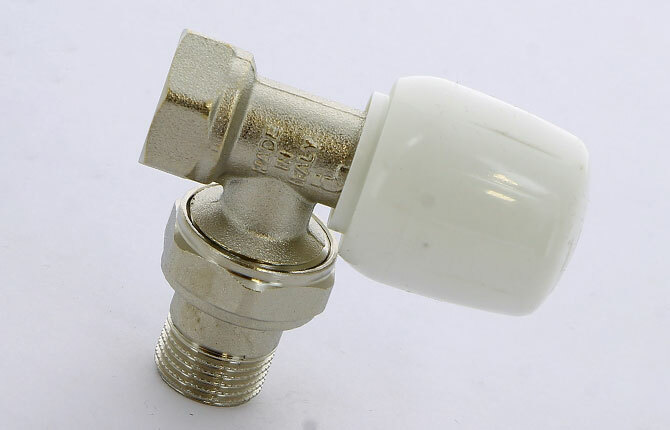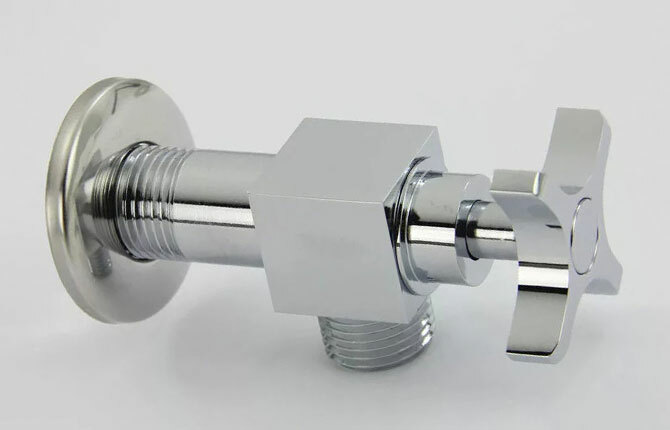Corner valves for a heating radiator - this is the type of valves that is responsible for regulating the supply of coolant to heating batteries. With their help, you can increase it, which leads to an increase in the temperature of the radiators. Or reduce to reduce. This is convenient not only in terms of maintaining a comfortable microclimate inside the premises, but also in terms of saving fuel on which the heating system operates.
The content of the article:
- Why do you need corner taps
- What are the advantages of a corner faucet
- How does a corner faucet work?
- What to look for when choosing a corner faucet
- How to install an angle valve depending on the operating conditions
Why do you need corner taps
There are three qualities of the corner device that affect the purpose of this type of valves:
- If it becomes necessary to repair the radiator or it needs to be replaced, then it can be used to turn off the coolant supply. Since two corner valves are installed on the radiator - one for the supply, the second for the return - both are turned off.
- If it is necessary to change the temperature regime inside the building, the volume of the supplied coolant is regulated.
- Angle valve - an option for draining the coolant, as well as for removing air from inside the radiators.

What are the advantages of a corner faucet
All features described are benefits. An additional plus is that such shutoff valves can regulate the temperature regime of each radiator, regardless of the heating system. For example, if you need to lower the temperature in a room that is rarely used, you just need to reduce the coolant supply in the radiator batteries installed in it. Or vice versa.
More often, angle-type taps are mounted in cases where the pipe connection to the radiators is located at an angle of 90º.
Other advantages:
- Compactness. A small device with great functionality - this was the task for the manufacturers. It should not stand out and fit even in uncomfortable places.
- Typically, radiators are connected to pipes that run parallel to the walls. Today, many pipelines are recessed into the same walls to make the piping invisible. The radiator can be connected by taps, and then a direct coolant regulator can be mounted. It is easier to install a corner crane, which combines two elements in the design.
- High reliability. The angle valves offered on the market are high quality products. And this is with a simple design.
- Ease of installation. Since corner locking devices are mounted in a limited space, it was the question of installation that the developers faced as a component of quality. Hence the speed and reliability of fixation.
- It is convenient to use them. To do this, turn the locking mechanism to one side.
- Appearance. More often this type of valves is in plain sight, so manufacturers try to pay a lot of attention to its design.
We have to give credit to the companies that are always working on corner valves. Here, not only design, but also an increase in their functionality. For example, models with a thermometer installed on one of the nozzles. A convenient option is that with its help you can track the temperature of the coolant.

How does a corner faucet work?
Before considering the principle of operation of angle control valves for heating radiators, you need to know that they are all divided into three groups depending on the type of locking device:
- Ball. Inside the case there is a ball with a through slot. When it is rotated 90º, either the coolant supply is closed or opened. With their help, it is easy to regulate the flow passing inside them. They are most often used in heating systems of apartments and houses. This option applies to manual views.
- Throttle. These are standard valves, the design of which includes a stem with a valve at the end. When the first rotates clockwise, the second decreases. It closes the hole through which the coolant moves. And vice versa. It is with such angle valves that it is easy to manually adjust the movement of the coolant.
- Thermostatic. This is essentially the same first option, only the thermal head is included in the kit. The adjustment process takes place automatically.
What to look for when choosing a corner faucet
Attention must be paid to which heating system it will be installed in. There are three of them:
- centralized;
- autonomous;
- heating in the form of boilers installed in multi-storey buildings right next to or inside the facility.
Each system has its own characteristics in terms of temperature and pressure of the coolant. Hence the selection norms in accordance with these parameters. For example, in houses with more than five storeys, the coolant pressure is 5-12 atm. Less than five - 2-3 atm. In an autonomous system - no more than 2 atm.
The coolant temperature depends on the average temperature of the region:
- at -20 ℃ - the temperature of the coolant should be 65-80 ℃;
- at -40 ℃ - 95-105 ℃.
It is impossible to install an angle valve on a radiator in a multi-storey building if it is designed for a pressure of 2 atm. The same with temperature.
The second point is the diameter of the valves. This size must be indicated on the product itself. When choosing, it must be identical to the diameter of the pipe to which it is attached.
The third position is the material from which the locking device is made. There are three options here:
- stainless steel;
- brass;
- polypropylene.
The first is expensive, but reliable, with a long service life - up to 50 years. The second one is cheaper and less reliable. Will last no more than 7-8 years. But this period is also good. The most popular is the third option:
- service life - 15 years;
- withstands pressure up to 10 atm, temperature up to +90 ℃.
Today on the market you can come across corner taps made of silumin. It is an alloy of aluminum and silicon. It is difficult to distinguish it from stainless steel in appearance. Product characteristics low. For example, the service life does not exceed 12 months. The price of silumin taps is low.
The fourth selection criterion is the installation method.
There are four positions here:
- with female thread on two tap nozzles:
- with external thread;
- combined version - on one branch pipe the thread is external, on the other internal;
- angle tap with an American for a radiator.
The latest model is preferred. The thing is that it allows you to install the crane without changing the location of the pipe and the valves themselves. To do this, unscrew or tighten the union nut, which is attached to the radiator with a threaded pipe fitting. This is especially important when it is necessary to dismantle the radiator battery. No need to cut something and then weld it.
The fifth selection criterion is the ability to pass a certain amount of coolant through itself.
| Corner type | Throughput, % |
| full bore | 100 |
| incomplete bore | up to 50 |
| Standard | 70-80 |
For heating radiators, it is better to choose a full-bore option. It will ensure the free passage of the coolant without any problems. This type of valves can only reduce the passage of the pipe through which hot water flows to the radiator. He cannot increase it.

How to install an angle valve depending on the operating conditions
Before installing a corner crane, you need to know some of the nuances of its installation:
- The place of installation must be freely accessible.
- The adjustment knob must be located so that it can be easily used.
- If there is an arrow on the body of the corner valve for the radiator indicating the direction of movement of hot water, then it should become a guide at the installation site.
- Threaded connections, especially for the radiator, must be completed with materials that create a tight joint. Fum tape or thread works well for this. They are screwed against the thread so that in the process of twisting the American pipe fitting clockwise, the material does not fluff.
The installation process itself is carried out as follows (for example, a crane with an American):
- The locking device is disassembled into two parts - the valve itself and the nut with a pipe.
- At the end of the latter, an FUM tape is wound.
- The same end is used to connect the pipe to the radiator.
- The union nut should have a collar: rubber or plastic.
- The angular tap is connected to the pipe of the heating system: soldering, threading.
- The nut is screwed onto the faucet pipe by hand.
After assembling the entire heating system, the joints are checked - it is filled with water and each connection is checked for leaks.
Corner set radiator taps - common stop valves. Ball models are especially popular. But experts recommend paying attention when buying to the material of manufacture. Stainless steel is the priority here. But brass and plastic also showed themselves well in operation. Moreover, these two materials are several times cheaper than stainless steel.
Radiator taps: video.
Share your experience with corner radiator taps in the comments. Did you choose and install? Save the article in bookmarks so as not to lose useful information.


